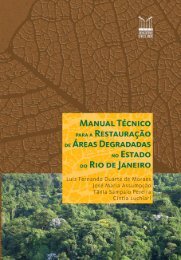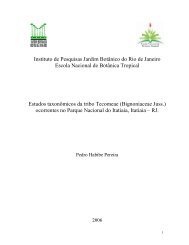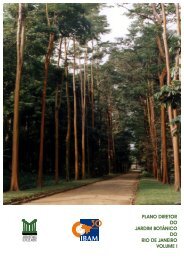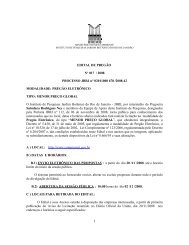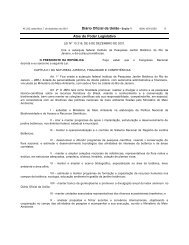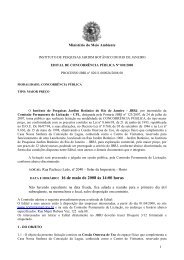anatomia do lenho e dendrocronologia de lianas da famÃlia ...
anatomia do lenho e dendrocronologia de lianas da famÃlia ...
anatomia do lenho e dendrocronologia de lianas da famÃlia ...
You also want an ePaper? Increase the reach of your titles
YUMPU automatically turns print PDFs into web optimized ePapers that Google loves.
49<br />
Senegalia tenuifolia (L.) Britton & Rose (Figure 3D, 4A) in microscopic observation shows<br />
distinct growth rings by semi-ring-porous; fibrous zone in latewood, radially flattened<br />
latewood cells; and marginal parenchyma. Fibrous zone and radially flattened latewood cells<br />
are not ever well-distinct on all samples and on all growth rings, but the absence of both<br />
features in the same growth ring is rare. Abun<strong>da</strong>nce of calcium oxalate prismatic crystals was<br />
observed in transition of growth rings. The macroscopic and microscopic observations<br />
provi<strong>de</strong> easy distinction of growth rings boun<strong>da</strong>ries.<br />
GENUS PIPTADENIA – MIMOSOIDEAE<br />
Pipta<strong>de</strong>nia adiantoi<strong>de</strong>s (Spreng.) J.F. Macbr. (Figure 3B, 4B) in microscopic observation<br />
shows distinct growth rings boun<strong>da</strong>ries marked by combination of: semi-ring-porous; fibrous<br />
zone; radially flattened latewood cells; marginal parenchyma. Abun<strong>da</strong>nce of calcium oxalate<br />
prismatic crystals in transition of growth rings was observed. Two specimens <strong>do</strong> not have<br />
well-distinct semi-ring porosity, showing a thin layer of vessel with few diameters in<br />
latewood. In the same two specimens not all growth ring boun<strong>da</strong>ries have well distinct fibre<br />
zone, because the pattern of <strong>de</strong>crease of confluence parenchyma bands toward the latewood<br />
making fibre zones are not followed. The macroscopic observation provi<strong>de</strong>s easy distinction<br />
of growth rings boun<strong>da</strong>ries than microscopic observation, because the presence of axial<br />
parenchyma lignified with thicker walls.<br />
Pipta<strong>de</strong>nia micracantha Benth. (Figure 3C, 4C) in microscopic observation shows distinct<br />
growth rings boun<strong>da</strong>ries marked by combination of: semi-ring-porous; fibrous zone; marginal<br />
parenchyma. Few growth rings show radially flattened cells on latewood. Abun<strong>da</strong>nce of<br />
calcium oxalate prismatic crystals in transition of growth rings was observed (Figure 5). The<br />
macroscopic and microscopic observations provi<strong>de</strong> easy distinction of growth rings<br />
boun<strong>da</strong>ries. Pipta<strong>de</strong>nia micracantha display to be the species with the anatomical features<br />
more constants <strong>de</strong>limiting growth rings.<br />
GENUS DALBERGIA – PAPILIONOIDEAE<br />
Dalbergia frutescens (Vell.) Britton var. frutescens (Figure 3A, 4D) in microscopic<br />
observation has distinct growth rings boun<strong>da</strong>ries marked by semi-ring porosity; marginal<br />
parenchyma; fibrous zone in latewood; and radially flattened latewood cells. The features



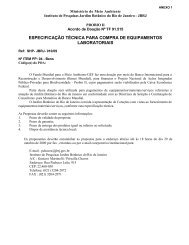
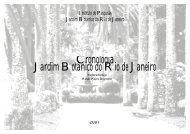
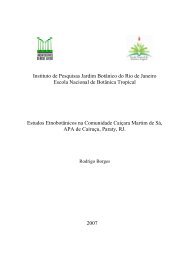
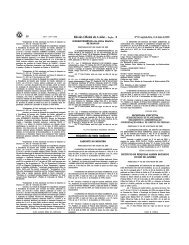
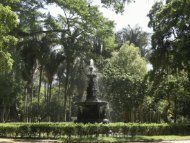
![Memorando nº [Número do memorando/DAMF-RJ/Nome da Unidade]](https://img.yumpu.com/43163661/1/184x260/memorando-na-namero-do-memorando-damf-rj-nome-da-unidade.jpg?quality=85)
